Shukubo
Koyasan is one large seminary of Shingon Buddhism that has kept its lanterns
burning since its founding in 861. Today, traditions are carried on by
117 temples including 53 shukubo or temples that provide lodging accommodations
and dining. These shukubo have images of Buddha and Japanese gardens, but
also offer a brand of sake called Hannyato and beer. Unlike a typical Japanese
inn, service such as waiting on guests and preparing and picking up bedding
is done by young men who are training to be Buddhist priests. Guests can
also try transcribing sutras or getting deep in meditation known as ajikan.
Come and enjoy the traditional vegetarian cuisine (shojinryori) and a peaceful
sleep in the tranquil surroundings of Koyasan. Also, every morning in the
main hall of the shukubo morning service is held which you can attend |
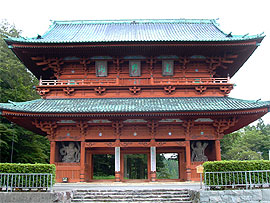 |
Daimon
This mammoth gate stands as the main entrance to Koyasan. It is flanked
on each side by Kongo warriors who guard the mountain. The vie from the
front of the gate is magnificent and, on a clear day, can reach as far
as the Seto Inland Sea. |
|
Konpondaito Pagoda
(Admission charged)
Standing 48.5m tall and situated right in the middle of Koyasan, this pagoda
was built as a seminary for the esoteric practices of Shingon Buddhism.
This pagoda and the Okunoin Temple form a large sanctuary. |
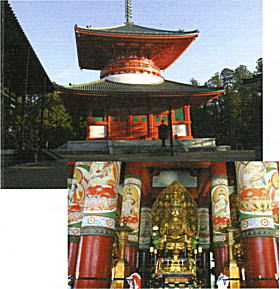 |
|
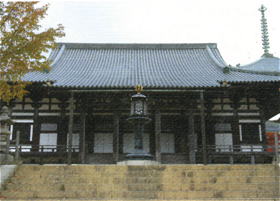
|
Kondo Hall (Admission charged)
Standing in the middle of Garan area, this is the main hall of Kongobuji
Temple.
First built in 819, the current structure is the 7th reconstructed in 1932 on the site.
The altar features a statue of tathagata physician of the souls done by
Koun Takamura, while the walls were painted by Buzan Kimura. Important
Buddhist services are performed here. |
|
Kongobuji Temple
(Admission charged)
Located roughly in the middle of the sanctuary, Kongobuji is the main temple of Shingon Buddhism. It is colloquially known as "Koyasan-Issan" , literally means "the mountain of Koya" . The temple was built by the warlord Hideyoshi Toyotomi for the mass of his mother when she passed away. Originally named Seiganji, it was later renamed Kongobuji in the Meiji Era. |
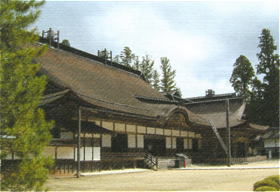 |
|
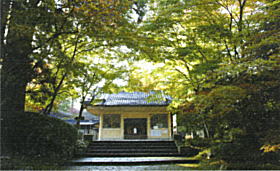 |
Reihokan(Admission charged)
The Reihokan displays a number of National Treasures
and Important Cultural Properties that recount the history and culture of the
local area and the temples such as Buddhist paintings and sculptures, altar
accessories, sutras, handicrafts and old books. |
|
Daishi Hall (Admission charged)
This large hall is for Daishi believers all over Japan who want to become
missionaries. It is the head temple of numerous other training facilities
across the country. The seminary that adjoins the hall was built in 1982. |
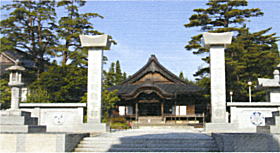 |
|
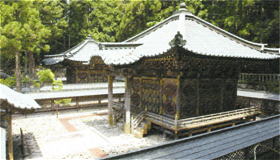 |
Tokugawa Family Tomb
(Admission charged)
This mausoleum was built by the third shogun Iemitsu Tokugawa. It took
ten years to build and is architecturally representative of the Edo Period.
First Edo shogun Ieyasu is enshrined on the right and second shogun Hidetada
on the left. The structure is elaborately decorated with ample use of carvings
and brass fittings. |
|
Choishimichi (Stone-marked path)
This pilgrimage path runs about 24 km from Jisonin Temple in Kudoyama to
Mt.Koya. Along the way, the route is marked every cho - or 109 m-by 2-meter
high stone markers which are shaped like pagodas. There are 180 to the
monastery in Koyasan and 36 more from there to Okunoin Temple. The journey
and climbing of this path is a true test of faith and a gesture of worship. |
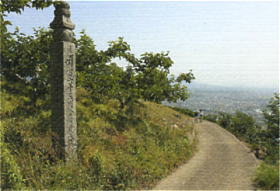 |
|
|
|
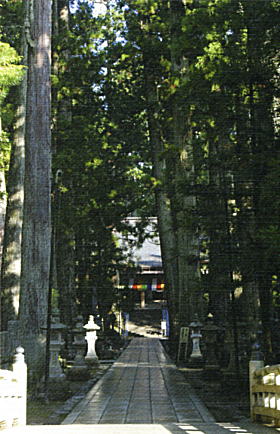 |
Okunoin
Surrounded by mountains on three sides and with the Tama River running
along the foot, Okunoin Temple sits in a tranquil location. Here you will
find the mausoleum of Kobodaishi, hall of lanterns, offerings hall, fudo
hall, mausoleum bridge, ossuary, sutra hall and mizukake jizo guardian
deities, where you throw the water over Buddhds figures for the mass of
the dead. This is the central sanctuary of the Diashi faith.
On the both sides of cemetery path a half million tombs develop impressive
aspect. |
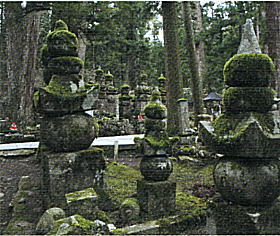 |
|
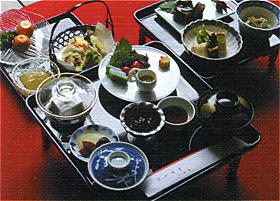 |
FOOD
A traditional vegetarian, gourmet food is called shojin-ryori in Japanese.
It is skillfully cooked without any use of meat, fish, onions, or garlic.
The delicate dishes are tempura, aghe, Koya-tofu, Goma-tofu, Miso soup,
sweet-and-sour seaweeds in vinegar, wild potatoes, and many others. The
most delicious one among them is called Goma-tofu cooked with sesame seeds
and starch. The taste is extremely good. Over 1,100 years, the old method
of cooking preparation [ recipe ] has been secretly transmitted from monk
to monk, chef to chef. |
|
Festivals
Aoba-matsuri: held on June 15, the festival celebrates the birthday of the founder Kobodaishi. Various traditional ceremonies are performed under the presence of a hundred priests.
Mando-e Festival: This festival is held on August 13, Thousands of lanterns/candlelights
are placed along the path to Okunoin mausoleum, for the eternal peace of
the deceased family members. Thousands of mourners participate in the ceremonial
service. |
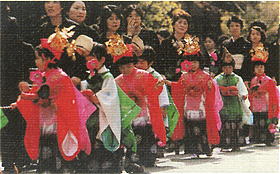 |
|
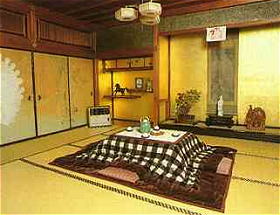 |
Lodging
There are fifty three historical temples to accommodate the visitors with
the traditional customs and manners typical in the mountainous areas. Each
temple is called a shukubo and welcomes you with full hospitality. The
shukubo has a beautiful Japanese garden, traditional lodging rooms with
shoji, tatami, and fusuma doors. You should stay at least one night so
that you should experience the typical Japanese way of life in a shukubo
temple. |
|
Souvenirs
The most interesting small gifts and charms for your friends and family
are: omie ( Daishi's portrait ), juzu rosary/ beads, Daishi-pendants, amulets
( omamori) for save driving, Diashi images, necklaces, Buddha's scrolls.,Koya-tofu
( dried tofu ), pilgrim items, umbrella pines, and symbolic figurines of
guardian deities, and many others. These items are very handy and are sold
at many gift stores or souvenir shops in the town. |
|
Handy Audio Guide for Koyasan Visitors
The compact, rental Audio Guide is available. To check it out, please contact
Chuo Information Office or ichi-no-Hashi Information Office, listed below. |
|